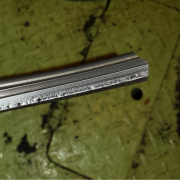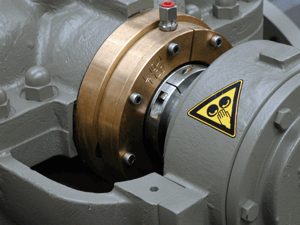Pump shaft seal failure and leakage is one of the most common reasons for pump downtime. In this blog we discuss the five most common reasons that cause a pump seal to leak.
- Wear down of the seal material
- Dry running
- Shocks and vibrations
- Wear down of the bearings
- Pressure drops or spikes
What is a pump shaft seal?
To refresh your mind, what exactly is a pump shaft seal? A pump shaft seal works on the rotating pump shaft where it passes through the non-rotating housing parts. Fluids enter your pump through the suction nozzle at the centre of a rotating impeller. As the impeller rotates, the vanes fill with fluid and are forced out of the pump housing through the discharge nozzle. Due to the discharge pressure, the fluid attempts to exit through the rotating shaft. The pump shaft seal allows the rotating shaft to enter the ‘wet’ area of the pump without leaking fluids.
Every pump shaft seal has a minimal (acceptable) consumption of fluids. Seal failure is defined as excessive leakage of fluids. The amount of leaking fluids is among other things determined by the pressure, wear, size, friction and rotating speed of the pump. Pump seal failure leads to loss of fluids and a dangerous working environment due to leakage. That’s why you want a reliable pump seal, which ensures optimal operation hours and keeps going.
The 5 most common reasons for a leaking pump shaft seal
1. Wear down of the seal material
A pump shaft is always sealed with materials around the shaft. It doesn’t matter which kind of seal your pump uses, there is usually contact (friction) between the shaft and seal. The materials from all shaft seals (gland packing, mechanical or Liquidyne®) always start to wear down because of the friction. The seal wears slower and has a longer lifetime when the material has less friction on the shaft.
The biggest challenge is to know when the seal has worn down and it’s time to plan maintenance. You want your seal to last as long as possible and to replace it as late as possible. By monitoring the drain flow of the Liquidyne, you can minimise the risk of sudden pump failure and optimise mean time between maintenance (MTBM). You can monitor the seal’s condition manually (with a bucket and stopwatch) or with a digital flow meter.
2. Dry running
A pump seal normally needs fluids to lubricate the materials around shaft. If there are no fluids available to lubricate, the seal runs dry which causes extra friction and heat. The seal will burn or melt and become damaged, which causes fluid leakage due to the pressure. Even a few seconds of dry running can cause heat cracks or blisters, which leads to a leaking pump shaft seal. Most dry running failures happen by restarting the pump after maintenance.
Heat cracks on a lip seal

3. Shocks and vibrations
Too much shocks and vibrations can cause large axial and radial play of the shaft. This leads to incorrect alignment and more leakage of fluids. Improper alignment, operating conditions or working past the pumps best efficiency point (BEP) can give too much vibration and reduce the seal’s lifetime. If your pump has to deal with heavy-duty conditions (like dredge pumps), make sure your seal can handle above-average axial and radial play!
4. Wear down of the bearings
As the shaft rotates, the bearings also have to deal with wear due to friction. If the bearings are worn out, it causes the shaft to swing. The movement of the shaft will cause vibrations, which consequences we have discussed at the previous point for pump seal leaking.
5. Pressure drops or spikes
If your pump has to deal with pressure drops or spikes, the wearing process will increase. The changing operating conditions will lead to an increasing leakage of fluids. Rubber lip seals are more forgiving in these circumstances and are less susceptible to this phenomenon.
Is your pump seal experiencing any excessive leakage of fluids or do you need help with troubleshooting? Contact us to maintain the current seal or replace it with our Liquidyne pump shaft seal. Our certified service engineers are your sealing experts and can support you both on location and remotely.


